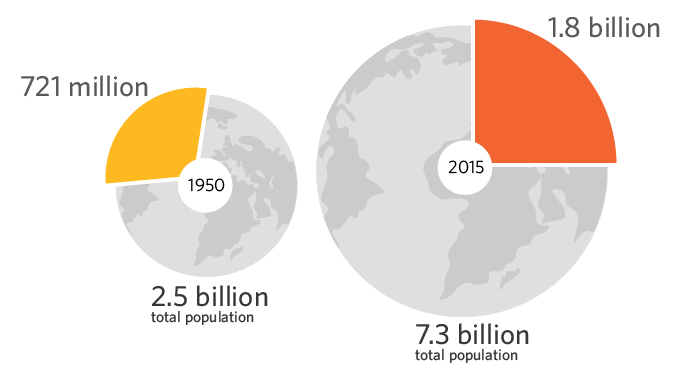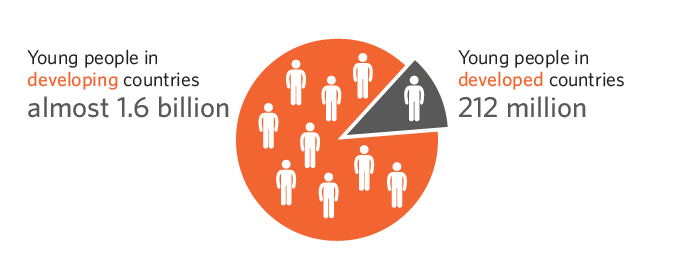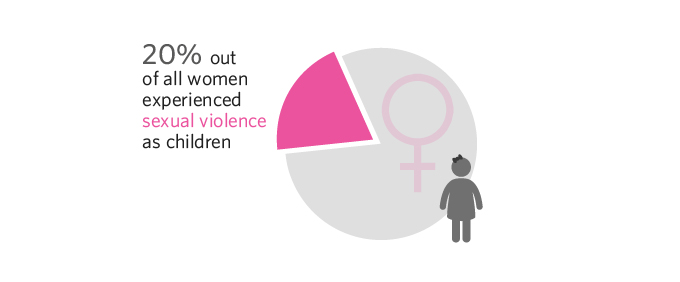Today is World Population Day, a day that calls attention on urgent population issues. This World Population Day spotlights the need to invest in teenage girls.
But what for and when is a World Population day?
World Population day is an annual event, observed on July 11 every year, which seeks to raise awareness of global population issues. The event was established by the Governing Council of the United Nations Development Programme in 1989. It was inspired by the public interest in Five Billion Day on July 11, 1987-approximately the date on which the world’s population reached five billion people.It encourages the activities, events and information to help make this right a reality throughout the world. World Population Day aims at increase people’s awareness on various population issues such as the importance of family planning, gender equality, poverty, maternal health and human rights. — From Wikipedia
Right now, the world population is 7,336,951,626 and it increased by the time i entered this number in this post, population increased by 10. Source : http://www.census.gov/popclock/
Below are some interesting charts published in unfpa.org on the occasion of World population day. These six graphics show why investing in teenage girls is absolutely critical – not only for girls, but for the world.
1. There are more young people today than at any other time in human history.
Today’s generation of young people, those aged 10 to 24, accounts for around 1.8 billion of the world’s 7.3 billion people. In 1950, there were only 721 million people in this age range.
These young people are the future. Their choices, ideas and innovations will transform the world – but only if they are equipped with the right skills and opportunities.

Source: UN DESA, 2015 estimates
2. About nine out of ten of these young people live in less developed countries
A whopping 1.59 billion young people live in the developing world, where they are more likely to face poverty and lack access to health care and education.
Yet this is exactly where healthy, educated and empowered young people could make the most difference.

Source: UN DESA, 2015 estimates
3. And half of these young people face alarming vulnerabilities – because they are girls.
Violence against women and girls is one of the world’s most prevalent human rights abuses. Half of all sexual assaults are committed against girls aged 15 or younger. Studies show that about 20 per cent of women experienced sexual violence as girls.
Too often, these crimes go unpunished. They may even be tacitly endorsed by sexist attitudes and practices like child marriage.

Source: World Health Organization, 2016
4. In developing countries, one in every three girls is married before reaching age 18.
A shocking one third of all girls in the developing world (excluding China) are married off while still children. This means the futures of 47,700 girls are derailed every day.
These girls often face a cascade of other human rights abuses. They are more vulnerable to physical and sexual violence. They are often pulled from school to take on domestic responsibilities. They are less able to advocate for themselves and their rights.

Source: UNFPA, 2016 estimates
5. Child marriage is often followed by pregnancy, even if a girl is not yet physically or mentally ready.
Every day, over 20,000 girls under age 18 give birth in developing countries – over 7 million a year.
Adolescent pregnancy is usually not the result of a deliberate choice. Rather, it is the consequence of an absence of choices. Girls who become pregnant tend to be poorer and to have little or no access to sexual and reproductive health care and information.
And pregnancy compounds their vulnerability, taking an enormous toll on their educations and future earning potential. It also vastly increases the risks to their health. In fact, complications from pregnancy and childbirth are the second leading cause of death among girls between 15 and 19 years old.

Source: UNFPA, 2015 estimates
6. But the solution to ending these human rights abuses is known: Empower girls.
When girls are valued as much as boys – when they are allowed to receive an education, when they live free of violence, and receive sexual and reproductive health information and care – they are able to stand up for themselves. Educated girls are more likely to delay marriage and pregnancy, and their future children are healthier. These girls are better able to meet their full potential, benefiting themselves, their families, their countries and the world.
We already see this happening. Since 1999, the number of countries with severe gender disparities in primary education has been cut by more than half. But girls continue to lag behind in secondary education: By 2012, out of all countries with data available, 63 per cent had yet to achieve gender parity in secondary school enrolment.

Source: Education for All, 2015
Much more must be done to protect teenage girls’ rights, and to ensure they have access to the same opportunities as boys.
“Governments everywhere need to invest in teenage girls in ways that empower them to make important life decisions and equip them to one day earn a living, engage in the affairs of their communities and be on an equal footing with their male counterparts,” said Dr. Osotimehin.
“A teenage girl whose rights are respected and who is able to realize her full potential is a girl who is more likely to contribute to the economic and social progress of her community and nation.”
– See more at: http://www.unfpa.org/WPD2016#sthash.Y5snxlBi.dpuf
Related Posts












